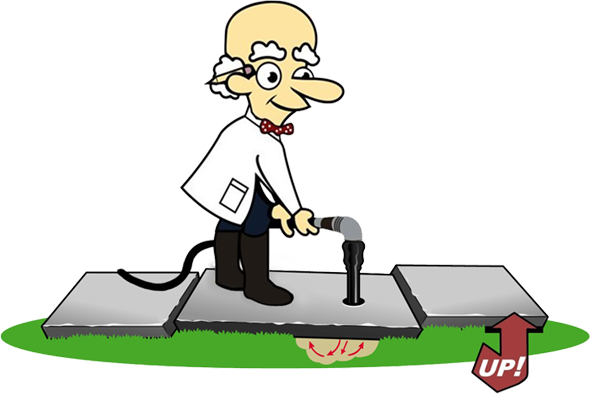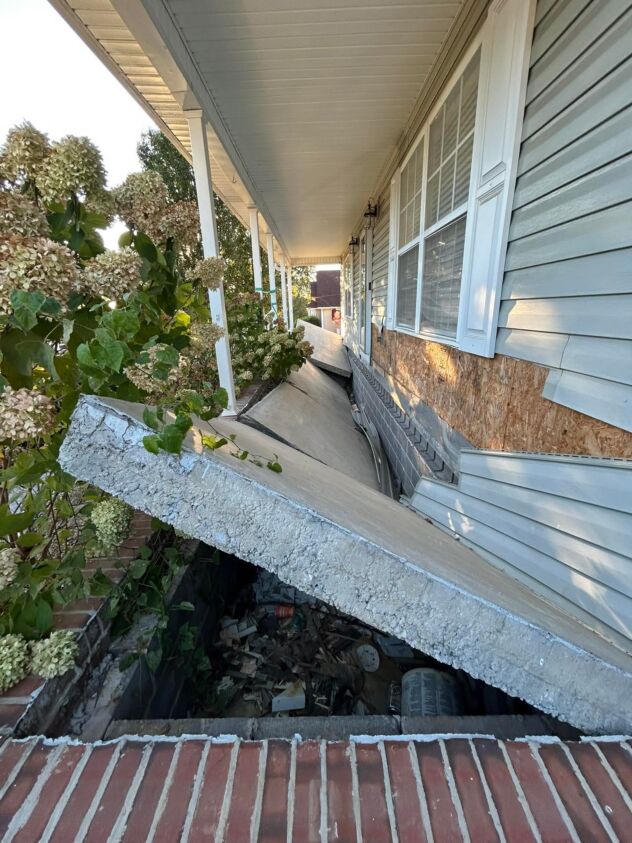IN THIS ARTICLE
Here are the likely reasons why your concrete porch collapsed
A concrete porch is supposed to be one of the strongest parts of your home or business property. It’s where guests step first, where kids play, where deliveries get dropped, and where you sometimes sit to enjoy the weather. But over the years, we’ve seen many porches fail or collapse — not because concrete is weak, but because the ground underneath slowly changed without anyone noticing.
In this article, we want to break down the five most common causes of concrete porch collapse, how you can spot early warning signs, and what you can do to prevent costly damage. We’ve been fixing uneven concrete for over 25 years in New Jersey and Eastern PA Areas, but our main goal here is to educate, whether you live in New Jersey, Eastern PA, or anywhere else.
Let’s start with the root causes that weaken porches.
1. Soil Erosion Beneath the Porch
Soil settlement and erosion are the silent enemy of concrete structures.. When backfilled soils reconsolidate, or rainwater, poor drainage, or leaking gutters wash soil away, the concrete slab loses the support it needs. Over time, the porch begins to settle unevenly, crack, or tilt forward.
How erosion happens:
- Downspouts dump water against the porch
- Landscaping slopes toward the house instead of away
- Heavy rainstorms loosen surface soils
- Underground water movement slowly pulls soil out
Once the soil disappears from under the slab, the porch is basically “floating.” And concrete doesn’t float for long.
Early warning signs:
- Gaps forming under the step risers
- A hollow sound when you knock the underside of the porch
- Water pooling around the foundation
- Small cracks where the porch meets the house
How to prevent erosion:
- Extend your downspouts at least 4–6 feet away from the porch
- Regrade soil so it slopes outward
- Keep gutters clean to avoid overflowing water
- Fix drainage issues before they start affecting the slab
Small erosion is normal. The problem is when it goes unnoticed for years.
2. Poor Soil Compaction During Construction
A concrete porch is only as strong as the soil it’s built on. If the builders didn’t compact the soil properly before pouring concrete, the ground will settle as time passes. That settling puts uneven pressure on the slab until it eventually cracks or sinks on one side.
This is extremely common in older homes, but even new homes sometimes suffer from rushed construction.
Why poor compaction happens:
- Builders poured concrete too soon
- Fill dirt wasn’t compressed layer by layer
- Different soil types were mixed together
- Heavy foot traffic or vehicles weren’t considered
You don’t see the problem immediately — it might take 5, 10, even 20 years before the porch shows signs of failure.
Warning signs:
- A porch that’s sinking toward one corner
- Cracks running from one edge to the house wall
- A visible gap between porch and foundation
- Doors near the porch sticking or misaligned
How to prevent settling:
- If building new, insist on proper soil compaction testing
- For existing homes, regularly inspect edges and foundation lines
- Fill any soil gaps you see forming around the porch
When the ground moves, concrete has no choice but to move with it.
3. Moisture Problems and Freeze–Thaw Damage
In climates like New Jersey and Eastern PA, freeze–thaw cycles are brutal on concrete. Water seeps into cracks, freezes, expands, melts, and repeats. This cycle pushes the concrete apart from within, making small cracks turn into structural weaknesses.
Over time, parts of the porch can break away, crumble at the edges, or fall inward.
Where moisture comes from:
- Cracks that allow rainwater inside
- Snowmelt pooling against the slab
- Porous concrete not sealed properly
- Moisture wicking up from the soil
In areas with cold winters, freeze–thaw is one of the biggest contributors to porch failure.
Warning signs:
- Flaking or crumbling edges
- Larger cracks each winter
- Concrete slabs raising at a joint or porch edge
- Chunks breaking off the steps
- Porous surface texture
How to prevent moisture damage:
- Seal your concrete every 2–3 years
- Keep snow and ice off the porch
- Fix cracks early, before water gets inside
- Improve drainage around walkways and stairs
Water is one of concrete’s biggest long-term threats.
4. Excessive Weight and Structural Overload
Concrete porches are strong, but they aren’t built to handle unlimited weight. If heavy objects sit on the porch — like stone planters, outdoor kitchens, masonry pillars, or even hot tubs — the slab may crack or shift under the load.
Many older porches were never designed to hold the kind of structures people add today.
Sources of excess weight:
- Brick or stone columns
- Large concrete planters
- Outdoor furniture made of solid stone
- Storage items
- Add-on structures fastened to the porch
The extra weight stresses the slab and the soil beneath. If the soil is already weak from erosion or poor compaction, the porch can collapse suddenly.
Warning signs:
- Cracks forming directly under heavy objects
- Sinking toward one side
- A bowed or tilted surface
- Creaking or shifting sounds when weight is applied
How to prevent overload:
- Avoid placing extremely heavy items near unsupported edges
- Distribute weight more evenly
- Strengthen support beams if the porch is elevated
- Inspect the porch every spring for movement
Sometimes it’s not the concrete that fails first; it’s the soil beneath that gives out.
5. Lack of Maintenance and Untreated Small Problems
Concrete porches rarely collapse out of nowhere. The truth is, they give warning signs — small cracks, lifting edges, slight sinking. But many homeowners ignore them because the porch still “looks fine.”
The longer problems stay untreated, the more expensive the repair becomes.
Common issues people ignore:
- Minor cracking
- A porch that sinks less than an inch
- Slight unevenness in the steps
- Bushes or trees growing too close
- Washouts during heavy rain
Eventually, all these little things come together to create a major structural failure.
Warning signs of a porch that needs attention:
- Water draining toward the house instead of away
- Soil washing out during storms
- A porch slab that rocks or moves slightly
- Expansion joints breaking apart
- A visible dip in the middle or corner
How to stay ahead of repairs:
- Inspect your porch twice a year
- Address drainage issues quickly
- Patch small cracks early
- Keep trees and large roots several feet away
- Call a professional if the porch starts sinking
Ignoring early signs is one of the biggest reasons collapse happens.
How to Fix a Sinking or Unstable Concrete Porch
If your porch is sinking or becoming uneven, the repair method matters. A lot of people jump straight into polyjacking, but we don’t recommend or encourage that method because the material can trap moisture, it is associated with health and environmental concerns, expand unpredictably, and isn’t always suitable for long-term stability.
A more reliable, time-tested option is mudjacking (also called slabjacking). This method lifts the slab by pumping a natural, stable material under it — usually a mixture of soil, water, and cement — which fills voids and restores the slab to its proper level.
It’s been used successfully for decades, especially in areas where soil movement is common.
How We Help Homeowners in New Jersey and Eastern PA To Fix Concrete Floor Issues
If you live in New Jersey or Eastern PA and you’re noticing sinking, cracking, or uneven concrete around your porch, walkway, or steps, this is exactly what we’ve handled for more than 20 25 years. We take our time to diagnose the soil issues, explain the best fix, and use proven mudjacking/slabjacking methods to bring your concrete back to a safe, level position.
We don’t rush jobs. We don’t upsell. We simply educate you on what’s happening beneath your concrete and give you practical solutions that actually work long-term.
If you want a friendly evaluation or just have questions, reach out to us — we’re always here to help.
Frequently Asked Questions
What is the biggest warning sign that a concrete porch might collapse?
The biggest red flag is visible sinking or separation between the porch and the house foundation. If you notice a widening gap, cracks that grow every few months, or soil washing out beneath the slab, those are strong indicators that the porch has lost support and needs attention quickly.
Can a sinking porch be repaired without replacing the entire slab?
Yes, in many cases the slab can be saved. Methods like mudjacking/slabjacking fill the empty space under the porch, lift it back to level, and restore proper support. Replacement is usually only necessary if the concrete itself is severely broken or structurally compromised.
How long does mudjacking last compared to polyjacking?
Mudjacking is known for long-term stability because the materials used (a soil–cement mixture) are natural, like the surrounding earth. Polyjacking uses foam, which can expand unpredictably or trap moisture. Many homeowners prefer mudjacking for its durability, reliability, and compatibility with changing soil conditions.
- How We Raised a Sunken Concrete Walkway in Sewell, NJ - November 20, 2025
- Carbon Fiber Foundation Repair: All You Need to Know - November 20, 2025
- 5 Common Causes of Concrete Porch Collapse (and How to Prevent It) - November 20, 2025









